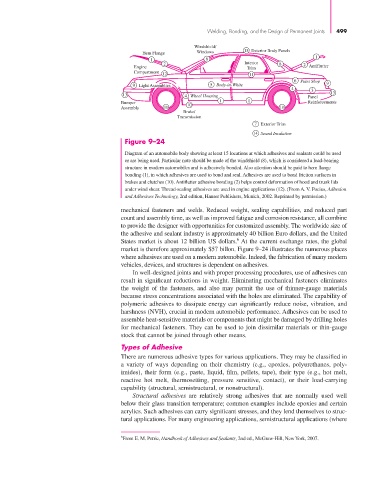Page 525 - Shigley's Mechanical Engineering Design
P. 525
bud29281_ch09_475-516.qxd 12/16/2009 7:13 pm Page 499 pinnacle 203:MHDQ196:bud29281:0073529281:bud29281_pagefiles:
Welding, Bonding, and the Design of Permanent Joints 499
Windshield/
Hem Flange Windows 15 Exterior Body Panels
1
1 8
2 Interior 8
Engine Trim 2 Antiflutter
Compartment
12 11
6 Paint Shop
9 Light Assemblies 5 Body-in-White 9
4 3
13 4 Wheel Housing Panel 13
1 1
Bumper 10 Reinforcements
Assembly 10 10
Brake/
Transmission
7 Exterior Trim
14 Sound Insulation
Figure 9–24
Diagram of an automobile body showing at least 15 locations at which adhesives and sealants could be used
or are being used. Particular note should be made of the windshield (8), which is considered a load-bearing
structure in modern automobiles and is adhesively bonded. Also attention should be paid to hem flange
bonding (1), in which adhesives are used to bond and seal. Adhesives are used to bond friction surfaces in
brakes and clutches (10). Antiflutter adhesive bonding (2) helps control deformation of hood and trunk lids
under wind shear. Thread-sealing adhesives are used in engine applications (12). (From A. V. Pocius, Adhesion
and Adhesives Technology, 2nd edition, Hanser Publishers, Munich, 2002. Reprinted by permission.)
mechanical fasteners and welds. Reduced weight, sealing capabilities, and reduced part
count and assembly time, as well as improved fatigue and corrosion resistance, all combine
to provide the designer with opportunities for customized assembly. The worldwide size of
the adhesive and sealant industry is approximately 40 billion Euro dollars, and the United
6
States market is about 12 billion US dollars. At the current exchange rates, the global
market is therefore approximately $57 billon. Figure 9–24 illustrates the numerous places
where adhesives are used on a modern automobile. Indeed, the fabrication of many modern
vehicles, devices, and structures is dependent on adhesives.
In well-designed joints and with proper processing procedures, use of adhesives can
result in significant reductions in weight. Eliminating mechanical fasteners eliminates
the weight of the fasteners, and also may permit the use of thinner-gauge materials
because stress concentrations associated with the holes are eliminated. The capability of
polymeric adhesives to dissipate energy can significantly reduce noise, vibration, and
harshness (NVH), crucial in modern automobile performance. Adhesives can be used to
assemble heat-sensitive materials or components that might be damaged by drilling holes
for mechanical fasteners. They can be used to join dissimilar materials or thin-gauge
stock that cannot be joined through other means.
Types of Adhesive
There are numerous adhesive types for various applications. They may be classified in
a variety of ways depending on their chemistry (e.g., epoxies, polyurethanes, poly-
imides), their form (e.g., paste, liquid, film, pellets, tape), their type (e.g., hot melt,
reactive hot melt, thermosetting, pressure sensitive, contact), or their load-carrying
capability (structural, semistructural, or nonstructural).
Structural adhesives are relatively strong adhesives that are normally used well
below their glass transition temperature; common examples include epoxies and certain
acrylics. Such adhesives can carry significant stresses, and they lend themselves to struc-
tural applications. For many engineering applications, semistructural applications (where
6 From E. M. Petrie, Handbook of Adhesives and Sealants, 2nd ed., McGraw-Hill, New York, 2007.

